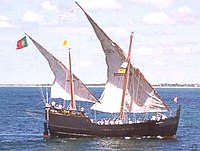Caravel
This article is about the Caravel boat type. For the carvel type of boat building, see Carvel (boat building).
This article may require copy editing for grammar, style, cohesion, tone, or spelling. (October 2008) |
This article needs additional citations for verification. (June 2008) |


A caravel is a small, highly maneuverable, two- or three-masted lateen-rigged ship, created by the Portuguese and used also by them and by the Spanish for long voyages of exploration from the 15th century. Its origins date back to the qarib used by Muslim Andalusian explorers in the 13th century.[2]
The Caravel
Although the carrack (or Nau) represented the state of the art in later medieval shipbuilding, there were purposes for which it was not appropriate. Initially carracks were used for exploration by the Portuguese venturing out along the west African coast and into the Atlantic Ocean. But the larger, full-rigged square-sailed ships could not always be sailed with the precision necessary for inshore surveying in unknown waters. The explorers soon came to prefer the Barge (Barca) or the Balinger (Barinel) of around 50 to 200 tons, or the light two or three-masted Mediterranean lateen-rigged vessels known as caravels.The Caravels also were very important as the Portuguese and the Spanish would not have been able to go through the Spice Trade
Because of its smaller size, the caravel as shown, was able to explore upriver in shallow coastal waters. With the lateen sails affixed, it was able to go speedily over shallow water and take deep wind, while with the square Atlantic-type sails attached, the caravel was very fast. Its economy, speed, agility, and power made the caravel esteemed as the best sailing vessel of its time. It generally carried two or three masts with lateen sails, while later types had four masts. Although widely used for exploration and discovery it was later replaced by the more capacious Nao which was more profitable for trading purposes.
Early caravels were usually two-masted boats of around 50 tons with an overall length of between 20–30 m and a high length-to-beam ratio of around 3.5:1 and narrow ellipsoidal (not circular as in the Nao) frames making them very fast and maneuverable but with somewhat low capacity. Towards the end of the 15th century the caravel was occasionally modified by giving it the same rig as a carrack with a foresail, square mainsail and lateen mizzen, but, unlike the unweatherly carrack, the caravel did not have a high forecastle or much of a sterncastle. In this form it was sometimes known as caravela redonda (a bulging square sail is said to be round or redonda in the Iberian tradition) and it was in such ships that Christopher Columbus set out on his famous expedition in 1492; Santa Maria was a small carrack which served as the flagship, and Pinta and Niña were slightly larger caravels of around 30 m with a beam of 6 m, displacing approximately 100 tons.
In the first half of the 16th century, a specialized fighting ship with that same name caravela redonda was created by the Portuguese to act as an escort in Brazil and in the East Indies route. It had a foremast with square sails and three other masts with a lateen each to a total of 4 masts. The hull was galleon-shaped (some experts consider this vessel a forerunner of the fighting galleon). The Portuguese Man o' War was named after this curious fighting ship type which was in use until the 18th century.
Notes
- ^ Notice in the Musée de la Marine.
- ^ John M. Hobson (2004), Eastern Origins of Western Civilisation, p. 141, Cambridge University Press, ISBN 0521547245.
References
- John M. Hobson (2004), The Eastern Origins of Western Civilisation, Cambridge University Press, ISBN 0521547245.
External links
- Museu da Marinha, Musée de la Marine, Paris
- Museu da Marinha, fac-similes, Musée de la Marine, Paris
- Instituto Camões. Caravela
- Durchbruch am Kap des Schreckens dir. Axel Engstfeld, Germany 2002, 52m. ZDF
caravel's rock!! oh and if you didnt realise their boats!
